2125 Santa Fe Ave.
The City of Long Beach named this park in March 1942 in honor of Rear Admiral Isaac Kidd, who had resided and was well-known in Long Beach in the years leading up to Pearl Harbor. Kidd was killed aboard his flagship Arizona on December 7, 1941, the highest ranking officer to die in the attack.
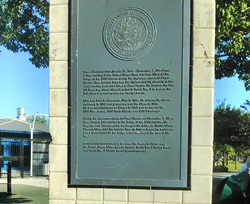
1126 Queens Highway, Long Beach
Built and launched in the 1930s, the Queen Mary was drafted into service in World War II as a troop transport in the Atlantic. Over the next six years she transported over 800,000 troops and thousands of war brides and children following the end of the war. Listed on the National Register of Historic Places in 1993, the ship has been in Long Beach since 1967.
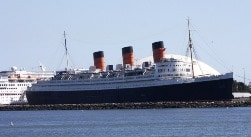
2002 – 2004 E. Ocean Blvd., Long Beach
These two concrete pads are all that remains of the Joint Army and Navy (known as JAAN) gun battery that was in operation during World War II. Established as part of the Harbor Defense of Los Angeles after the attack on Pearl Harbor, the JAAN-2 Battery served as a sub-post to the U.S. Army Coastal Artillery post at Fort MacArthur.

3000 E. Ocean Blvd., Long Beach
One of twelve identical bronze statues around the country based on the original at the Navy Memorial in Washington, D.C., the Lone Sailor Memorial at Bluff Park pays tribute to the enduring naval heritage of the United States.
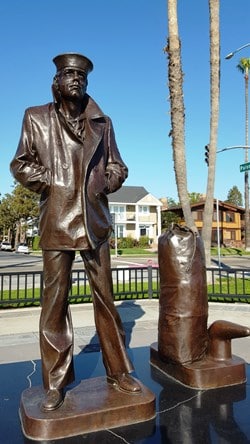
4100 Donald Douglas Dr., Long Beach
Built as a result of federally funded airport expansion, the distinctive Municipal Airport building functioned as both a terminal and administration headquarters. The building officially opened on April 25, 1942 and was designed by local architects W. Horace Austin and Kenneth S. Wing Sr. During World War II, the building also served as the headquarters for the Civilian Air Patrol. Mosaic art work created by Grace Clements under the WPA Federal Art Project adorn the interior.

Lakewood Blvd. at Carson St., Lakewood
The Douglas Aircraft plant in Long Beach opened just weeks before the attack on Pearl Harbor. Four different types of military aircraft were produced there during World War II. At peak production the plant employed over 40,000, roughly half that number women. The Douglas plant turned out nearly 9,500 planes and was the largest single producer of aircraft in terms of airframe weight during World War II. While nothing remains of the plant, the Douglas Park industrial park occupies the same tract of land the plant once did.
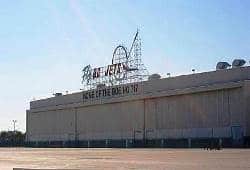
4900 E. Conant St., Long Beach
The park and memorial near the former site of the Douglas Plant honors the women who served in vital manufacturing jobs during the war as well as Women’s Airforce Service Pilot’s (WASPs) that delivered military planes to points throughout the country.
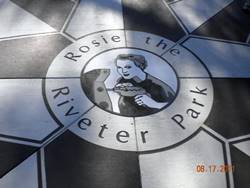
Lakewood Blvd. & Carson St., Lakewood
Dedicated by employees of the McDonnell Douglas Corporation (the successor of Douglas Aircraft Co.), this stunning black granite memorial honors the sacrifices of men and women who have served the country in war and peace. Features an extensive World War II timeline.
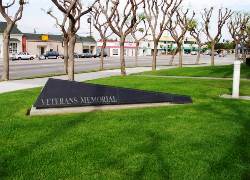
5901 E. Seventh St., Long Beach
The current VA Medical Center occupies the original site of the first Naval Hospital built in Long Beach. The hospital commissioned in December 1942 and opened in 1943 to treat personnel wounded in the Pacific Theater.
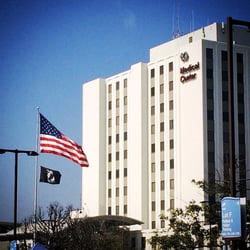
11206 Lexington Dr., Los Alamitos
Commissioned in 1942 as an auxiliary air station and later upgraded to a Naval Air Station, the JFTB (also called the Los Alamitos Army Airfield) opened to alleviate the heavy air traffic congestion at Long Beach Airport as a result of the war. As the Army Air Forces expanded their base at Long Beach Airport, the air base in Los Alamitos took on the bulk of naval aviation operations in this area.
800 Seal Beach Blvd., Seal Beach
The Naval Weapons Station was commissioned in 1944 as the Naval Ammunition and Net Depot used for the storage and loading of ammunition onto
Pacific Fleet ships bound for the war. Today the base still serves as the Navy’s primary West Coast ordnance storage, loading and maintenance installation.
800 Seal Beach Blvd., Seal Beach (at Main Gate of Naval Weapons Station)
This memorial includes plaques for each of the 52 U.S. submarines lost in World War II. On Memorial Day every year, the Tolling of the Boats Ceremony commemorates those who made the ultimate sacrifice for their country while serving aboard U.S. Navy submarines.
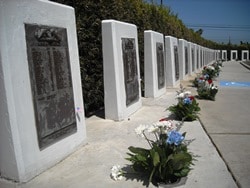
Inaccessible: now a private container terminal on Terminal Island
On what is now Pier T in the Port of Long Beach, the U.S. Navy once operated a major base and shipyard. Roosevelt Base commissioned in September 1942 and served as a major training facility for sailors serving in the Pacific Theater. The U.S. Naval Dry Docks commissioned in February 1943 and played a vital role in repairing battle-damaged ships. Following the war they were renamed the L.B. Naval Station and L.B. Naval Shipyard, which closed in 1994 and 1997 respectively.
1124 South Seaside Ave., San Pedro (Terminal Island)
This memorial commemorates the fishing village of Fish Harbor on Terminal Island, which for forty years was a thriving community of 3000 people, mainly Japanese immigrants and their American-born children. Due to wartime fears, in February 1942 all villagers of Japanese descent were given 48 hours to evacuate the island and later a vast restricted zone along the West Coast. By April, the village had been razed and the residents sent to internment camps.

3601 S. Gaffey St., San Pedro
The U.S. Army post at Fort MacArthur guarded Los Angeles and Long Beach harbors from 1914 to 1974. During World War II it served as the regional Coastal Artillery headquarters, which was responsible for protecting the coastline of Southern California from a potential enemy attack. Part of the original site currently serves as a museum documenting local military history.

Berth 49, San Pedro
The Lane Victory is a World War II era ‘Victory’ ship built by the California Shipbuilding Corp. on Terminal Island in 1945. Cargo ships such as these were responsible for transporting the bulk of war materiel to theaters around the world. Designated a National Historic Landmark in 1990.

250 S. Harbor Blvd., San Pedro
The lead ship in the last class of U.S. battleships, the Iowa commissioned in February 1943. She participated in major naval campaigns in the Pacific Theater in 1944-45.
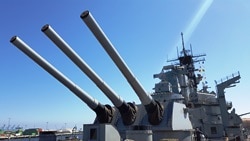
Berth 84, San Pedro
Located in the old Municipal Ferry Terminal building built in 1941 and listed on the National Register of Historic Places, the Maritime Museum chronicles the history of seafaring and the many changes Los Angeles harbor has undergone in its development into one of the world’s largest ports. The Navy Hall (under renovation) exhibit will focus on the naval history of Los Angeles and the four ships to have been named after the city.
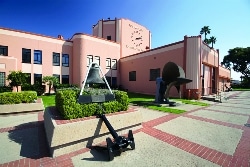
Shoreline Park, Aquarium Way, Long Beach
The Navy Memorial pays tribute to the long and proud history of the U.S. Navy in Long Beach in the 20th century. Home to many ships of the Pacific Fleet in the 1920s and 30s, the Navy presence here increased significantly as a result of World War II. The armillary sphere was commissioned by the Long Beach Navy Memorial Heritage Association and designed by Terry Braunstein.
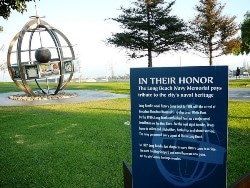
This guide to local World War II historical sites, memorials, and points of interest is an outgrowth of the Historical Society of Long Beach exhibition Long Beach Remembers Pearl Harbor. On December 7, 1941, Japan attacked the U.S. Pacific Fleet at Pearl Harbor, an event that galvanized our nation and plunged it into war. Dozens of naval vessels had been previously based in San Pedro Bay and over 100 sailors who died that morning called Long Beach home.
While the country as a whole transformed dramatically as a result of World War II, few regions experienced this transformation as intensely as greater Long Beach: the arrival of defense industries, rapid construction of military installations, a population explosion, profound demographic shifts, among many changes, left an indelible mark on this city.
The following list is not definitive, but representative of the both tragic and proud legacy of World War II here. Some sites can still be visited; for others only memorials serve as reminders of this rich legacy.
1. Admiral Kidd Park
2125 Santa Fe Ave.
The City of Long Beach named this park in March 1942 in honor of Rear Admiral Isaac Kidd, who had resided and was well-known in Long Beach in the years leading up to Pearl Harbor. Kidd was killed aboard his flagship Arizona on December 7, 1941, the highest ranking officer to die in the attack.
2. RMS Queen Mary
1126 Queens Highway
Built and launched in the 1930s, the Queen Mary was drafted into service in World War II as a troop transport in the Atlantic. Over the next six years she transported over 800,000 troops and thousands of war brides and children following the end of the war. Listed on the National Register of Historic Places in 1993, the ship has been in Long Beach since 1967.
3. JAAN 2 Battery
2002 – 2004 E. Ocean Blvd.
These two concrete pads are all that remains of the Joint Army and Navy (known as JAAN) gun battery that was in operation during World War II. Established as part of the Harbor Defense of Los Angeles after the attack on Pearl Harbor, the JAAN-2 Battery served as a sub-post to the U.S. Army Coastal Artillery post at Fort MacArthur.
4. Lone Sailor Maritime Memorial
3000 E. Ocean Blvd.
One of twelve identical bronze statues around the country based on the original at the Navy Memorial in Washington, D.C., the Lone Sailor Memorial at Bluff Park pays tribute to the enduring naval heritage of the United States.
5. Long Beach Airport Original Administration Building
4100 Donald Douglas Dr.
Built as a result of federally funded airport expansion, the distinctive Municipal Airport building functioned as both a terminal and administration headquarters. The building officially opened on April 25, 1942 and was designed by local architects W. Horace Austin and Kenneth S. Wing Sr. During World War II, the building also served as the headquarters for the Civilian Air Patrol. Mosaic art work created by Grace Clements under the WPA Federal Art Project adorn the interior.
6. Douglas Park
Lakewood Blvd. at Carson St.
The Douglas Aircraft plant in Long Beach opened just weeks before the attack on Pearl Harbor. Four different types of military aircraft were produced there during World War II. At peak production the plant employed over 40,000, roughly half that number women. The Douglas plant turned out nearly 9,500 planes and was the largest single producer of aircraft in terms of airframe weight during World War II. While nothing remains of the plant, the Douglas Park industrial park occupies the same tract of land the plant once did.
7. Rosie the Riveter Park and Interpretive Center
4900 E. Conant St.
The park and memorial near the former site of the Douglas Plant honors the women who served in vital manufacturing jobs during the war as well as Women’s Airforce Service Pilot’s (WASPs) that delivered military planes to points throughout the country.
8. United Aerospace Workers/McDonnell Douglas Veterans Memorial
Lakewood Blvd. & Carson St.
Dedicated by employees of the McDonnell Douglas Corporation (the successor of Douglas Aircraft Co.), this stunning black granite memorial honors the sacrifices of men and women who have served the country in war and peace. Features an extensive World War II timeline.
9. Long Beach VA Medical Center (First Naval Hospital site)
5901 E. Seventh St.
The current VA Medical Center occupies the original site of the first Naval Hospital built in Long Beach. The hospital commissioned in December 1942 and opened in 1943 to treat personnel wounded in the Pacific Theater.
10. Joint Forces Training Base
11206 Lexington Dr., Los Alamitos
Commissioned in 1942 as an auxiliary air station and later upgraded to a Naval Air Station, the JFTB (also called the Los Alamitos Army Airfield) opened to alleviate the heavy air traffic congestion at Long Beach Airport as a result of the war. As the Army Air Forces expanded their base at Long Beach Airport, the air base in Los Alamitos took on the bulk of naval aviation operations in this area.
11. Naval Weapons Station Seal Beach
800 Seal Beach Blvd., Seal Beach
The Naval Weapons Station was commissioned in 1944 as the Naval Ammunition and Net Depot used for the storage and loading of ammunition onto
Pacific Fleet ships bound for the war. Today the base still serves as the Navy’s primary West Coast ordnance storage, loading and maintenance installation.
12. U.S. Submarine Veterans World War II National Memorial West
800 Seal Beach Blvd., Seal Beach (at Main Gate of Naval Weapons Station)
This memorial includes plaques for each of the 52 U.S. submarines lost in World War II. On Memorial Day every year, the Tolling of the Boats Ceremony commemorates those who made the ultimate sacrifice for their country while serving aboard U.S. Navy submarines.
13. Roosevelt Base/U.S. Naval Dry Docks
Inaccessible: now a private container terminal on Terminal Island
On what is now Pier T in the Port of Long Beach, the U.S. Navy once operated a major base and shipyard. Roosevelt Base commissioned in September 1942 and served as a major training facility for sailors serving in the Pacific Theater. The U.S. Naval Dry Docks commissioned in February 1943 and played a vital role in repairing battle-damaged ships. Following the war they were renamed the L.B. Naval Station and L.B. Naval Shipyard, which closed in 1994 and 1997 respectively.
14. Japanese Fishing Village Memorial
1124 South Seaside Ave., San Pedro (Terminal Island)
This memorial commemorates the fishing village of Fish Harbor on Terminal Island, which for forty years was a thriving community of 3000 people, mainly Japanese immigrants and their American-born children. Due to wartime fears, in February 1942 all villagers of Japanese descent were given 48 hours to evacuate the island and later a vast restricted zone along the West Coast. By April, the village had been razed and the residents sent to internment camps.
15. Ft. MacArthur Museum – Battery Osgood-Farley Historic Site
3601 S. Gaffey St., San Pedro
The U.S. Army post at Fort MacArthur guarded Los Angeles and Long Beach harbors from 1914 to 1974. During World War II it served as the regional Coastal Artillery headquarters, which was responsible for protecting the coastline of Southern California from a potential enemy attack. Part of the original site currently serves as a museum documenting local military history.
16. SS Lane Victory
Berth 49, San Pedro
The Lane Victory is a World War II era ‘Victory’ ship built by the California Shipbuilding Corp. on Terminal Island in 1945. Cargo ships such as these were responsible for transporting the bulk of war materiel to theaters around the world. Designated a National Historic Landmark in 1990.
17. USS Iowa (BB-61)
250 S. Harbor Blvd., San Pedro
The lead ship in the last class of U.S. battleships, the Iowa commissioned in February 1943. She participated in major naval campaigns in the Pacific Theater in 1944-45.
18. Los Angeles Maritime Museum
Berth 84, San Pedro
Located in the old Municipal Ferry Terminal building built in 1941 and listed on the National Register of Historic Places, the Maritime Museum chronicles the history of seafaring and the many changes Los Angeles harbor has undergone in its development into one of the world’s largest ports. The Navy Hall (under renovation) exhibit will focus on the naval history of Los Angeles and the four ships to have been named after the city.
19. Long Beach Navy Memorial
Shoreline Park, Aquarium Way
The Navy Memorial pays tribute to the long and proud history of the U.S. Navy in Long Beach in the 20th century. Home to many ships of the Pacific Fleet in the 1920s and 30s, the Navy presence here increased significantly as a result of World War II. The armillary sphere was commissioned by the Long Beach Navy Memorial Heritage Association and designed by Terry Braunstein.
